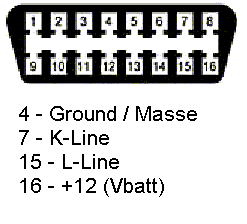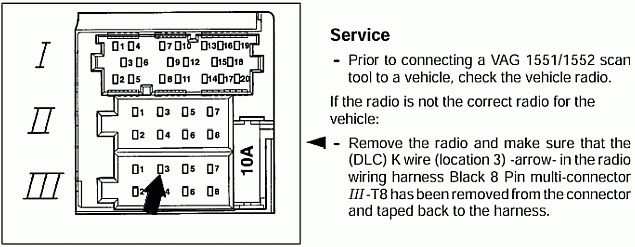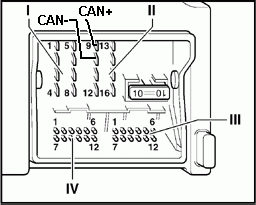|
|
| Home Products VAG-COM F.A.Q Index Aftermarket Radio |
The "Aftermarket Radio Problem"
Background:
Somewhere between 1997 and 1998, VW and Audi
started using diagnostics-capable radios in most of their models. That
means the dealer's scan tools (and our own VAG-COM system) can
talk to the radio. Why? So you can set various options, like whether a CD
player is connected, whether there's an amplified or conventional antenna,
and so on. In addition, these radios constantly monitor their
speaker outputs and if you have an open or short circuit to one of the
speakers, even a momentary one, they will record a fault code.
The
problem is, VW brought the "K-Line", the wire on which all of the control
modules in the car communicate with the scan-tool to a pin in the
connector on which older radios used to put +12 back into the
harness. (We're not sure whether this was for antenna power or as an
amplifier turn-on or what). So if you were to take the
non-diagnostics capable radio out of a 1997 GTI and put it in
a 1998 (where there should be a diagnostics-capable one), it fits
perfectly, plugs right into the harness, but the K-line ends up shorted to
+12!
Aftermarket
Radios
Now people hardly ever put
older stock radios in newer cars. What they often do is install better
after-market radios. And they most often do this by using an aftermarket
adapter-harness which plugs right into the car's harness, so they don't
have to cut up the car's harness. Trouble is, some of the aftermarket
harnesses faithfully reproduces the older, non-diagnostics radios with a
loop of wire between +12 and the pin where the K-line is on newer models.
So you install your fancy new radio with one of these and everything works
fine until.. somebody plugs in a scan tool.
The Problem
Nothing in the car cares if the K-line is shorted to +12. The
K-Line is not used for intra-vehicle communications. But a scan-tool
initializes a communications session by pulling the K-line to ground. The
K-line is supposed to have some voltage on it, but through a
high-impedance source. If the K-line has "hard" +12 on it, something has
to give! What "gives" is usually the scan-tool's output driver for
the K-line. And fixing a VAG-1551/1552 with a blown K-line driver is
expen$ive! But the ISO-COM
PC<->Car interface adapter that we provide with our VAG-COM software
has a small user-replaceable fuse
protecting the K-Line output driver, and there's a spare fuse taped under
the lid of the little box. No big worries there..:-) Our other
interfaces use output drivers that are thermally protected against
shorts. They don't need a fuse. If you plug them into a car
with the K-line shorted to +12, they simply won't work in that car, but it
won't hurt them either.
The Dealers
Some dealers
will refuse to scan any car that has an aftermarket radio. Since
most dealers have "killed" a few of their very expensive scan-tools, I can
sort of understand why. The best solution: Buy our
VAG-COM software and scan it yourself..:-) If you can
successfully scan the car with VAG-COM, you know it's safe -- and can
likely convince the dealership that it's safe too.
Test for this problem
yourself
You can test for this
problem yourself without removing the radio. First, if your car is a
1996 or earlier model, don't bother -- the K-Line doesn't go to the radio
harness and there is no possibility that that the car has this
problem.
If you have a Vag-Saver : Simply turn the ignition ON and plug in the Vag-Saver. Look at the LED. Green is OK, Red is not OK.
If you have a volt-meter: measure the voltage between pins 4 and 7 of the diagnostic connector with the ignition and radio turned ON. If it's under 9V, your K-line is fine. If it's over 9V, the results are inconclusive. You'll need a 1k Ohm (approximately) resistor. Put it between pins 4 and 7 of the diagnostic connector. Now use the volt-meter to measure the voltage between 4 and 7 (in parallel with the resistor). If it's under 1V, you don't have the problem. If it remains near 12V (the resistor will get hot!) you do have this problem and you'll need to fix it per the the instructions below.
If you don't have a volt-meter: Go to Radio-Shack and buy a 1K-ohm resistor. I think they cost $0.99 for a pack of 5. Temporarily place the resistor between pins 4 and 7 of your diagnostic connector. Ensure it's making contact with both pins. If the resistor gets hot, your K-line is shorted to +12. If it does not get hot, you're fine. Do NOT install this resistor in the port. You are simply using it to check and see if the k-line has +12V. If the resistor gets hot, then pull it out and fix the problem by disconnecting the k-line from the stereo's wiring harness.
The Diagnostic
Connector

Fix the
Problem:
Remove the radio.
Then make the following modification to the car's wiring
harness:

Note: 2002+
"Premium VI" Radio:
Some 2002 and
newer VW's come with the double-DIN "Premium VI" radio. This radio does
not have a k-line connection, but rather has a CAN-high and CAN-low.
Although the connector is completely different and it shouldn't be
possible to have the "Aftermarket Radio Problem" with these newer cars, it
would probably be in your best interest to make sure that NOTHING is
connected to these pins in the radio harness, if you use an aftermarket
radio. The back of the Premium VI radio is shown
in the below diagram.
 |
8 pin multi-connector II 9 - CAN-Bus plus 10 - CAN-Bus minus |
More
Questions?
mailto:Support@Ross-Tech.com
| Home Products VAG-COM F.A.Q Index Aftermarket Radio |

